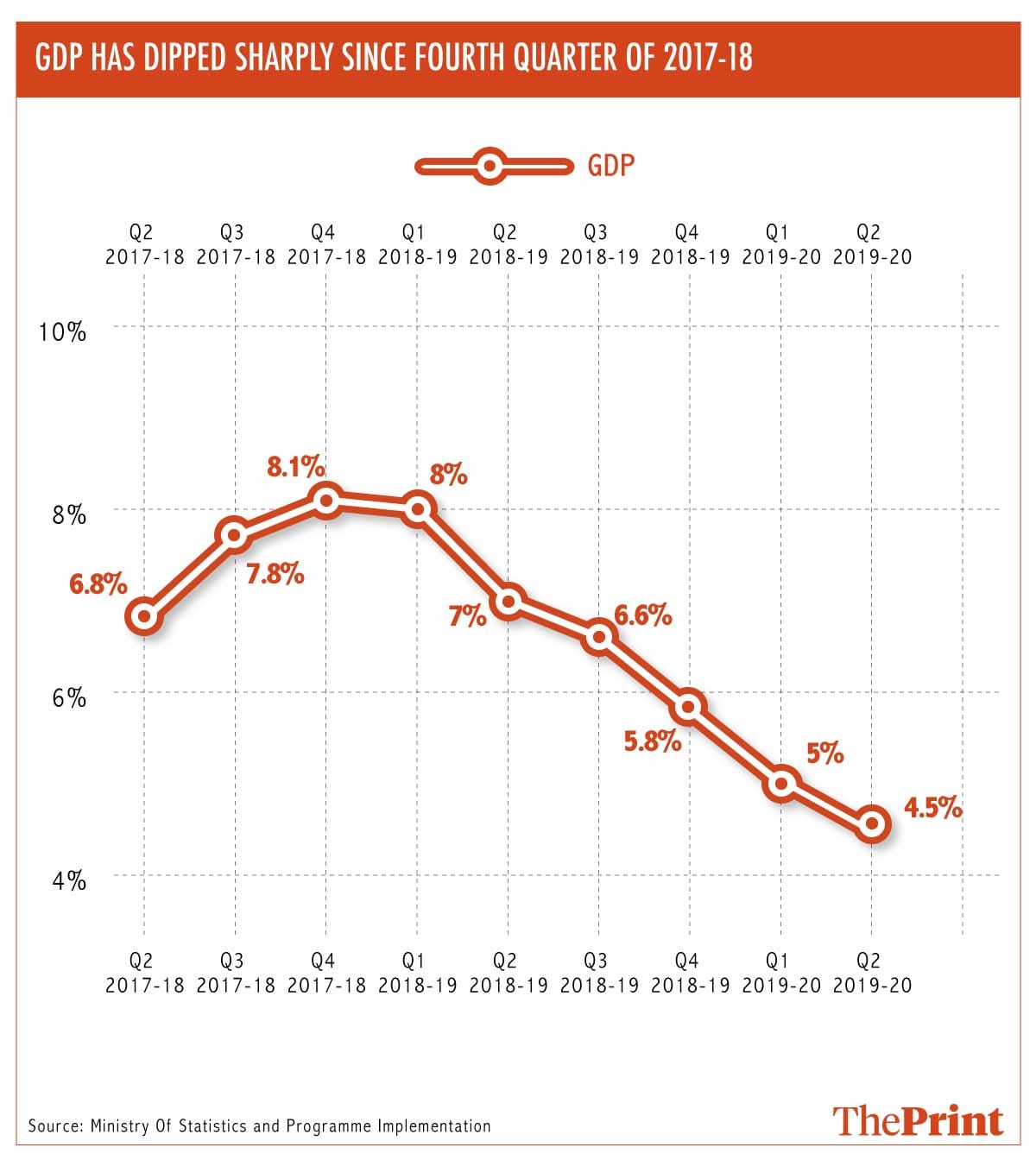New Delhi: The Indian economy grew at the slowest pace in six years at 4.5 per cent in the July-September quarter, increasing pressure on the Narendra Modi government to announce fiscal measures to revive demand in the economy.
This is the sixth consecutive quarter to register falling growth, led by a contraction in manufacturing and deceleration of growth in construction, electricity and some service sectors.

The Indian economy had grown at 5 per cent in the first quarter of the 2019-20 financial year, which means GDP growth in the first half of the fiscal was at 4.8 per cent.
The growth rate was 5.8 per cent in the final quarter of the previous financial year, led by a fall in consumption and investment.
The numbers do not come as a surprise, as a string of data released over the last few months indicated a sharp contraction in manufacturing activity, exports and sluggish demand. Contraction in factory output and fall in automobile sales all indicated that the GDP numbers for the July-September quarter would be lower than the previous quarter.
Along with rising inflation, these growth numbers will again bring to the fore concerns of stagflation — a situation where persistent high inflation is combined with stagnant demand.
Also read: Fall in GDP growth needs to be reversed before it becomes a sustained downward spiral
Gloomy numbers
Data released by the National Statistical Office showed that while manufacturing contracted by 1 per cent in the July-September quarter, agriculture grew by 2.1 per cent, construction by 3.3 per cent and electricity generation by 3.6 per cent.
Gross fixed capital formation — a key indicator of investment demand in the economy — grew at only 1 per cent in the September quarter as against 4 per cent in the June quarter and 12 per cent in the year-ago period. Private final consumption expenditure grew 5.1 per cent in Q2, marginally higher than the 3 per cent recorded in Q1, but lower than the 9.7 per cent growth in Q2 last year.
Data indicates that government final consumption expenditure helped in supporting falling growth. Government final consumption expenditure grew by nearly 16 per cent in the quarter, up from 9 per cent in the first quarter and 11 per cent in the year-ago period.
Nominal GDP growth, or GDP growth including the price effect, was at 6.1 per cent in the quarter, nearly half of the 12 per cent recorded in the year-ago period.
Sunil Kumar Sinha, principal economist at India Ratings and Research said the slowdown in GDP growth is largely on account of the slump in consumption expenditure and degrowth in exports, with government expenditure growth stemming the fall in GDP numbers.
Sinha said the gross fixed capital formation growth at 1 per cent shows that the “economy is passing through a declining growth momentum and there is no easy way out”.
He added that in the current domestic and global macro environment, the government will have to do the heavy lifting to support growth.
What RBI is expected to do
The sharp slowdown in growth is likely to prompt another rate cut by the Reserve Bank of India in the monetary policy announcement due on 5 December. Economists expect a 25 basis points rate cut, despite retail inflation numbers for October exceeding the inflation target of 4 per cent mandated by the Reserve Bank of India.
The RBI has cut key policy rates by 135 basis points since February this year while simultaneously paring its growth forecast for 2019-20 by 1.3 percentage points to 6.1 per cent. The central bank is expected to lower the growth forecast for 2019-20 again on 5 December.
Aditi Nayar, principal economist at ICRA Ltd, said that the RBI’s monetary policy committee is likely to reduce the repo rate by 25 basis points in its December review to support economic growth, looking through the vegetable price-led uptick in the CPI inflation in October 2019.
Economists expect the full-year GDP growth to slow down to around 5 per cent. Many have advocated an increase in government spending and a fiscal boost through personal income tax rates to revive the economy.
India, which was the fastest growing major economy until a few quarters back, now lags behind China, which grew at 6 per cent in the quarter ended September.
Atanu Chakraborty, secretary of the Department of Economic Affairs, said in a press conference after the release of the GDP numbers that growth is likely to pick up from the third quarter of the fiscal.
Also read: Slow economic growth is both immoral and anti-national. Don’t ignore falling GDP rate
This report has been updated with details from the NSO report and quotes from economists.







October-November 2019 has witnessed a swift and elephantine activity in India’s economic sector. The Central Govt has announced a number of measures of big magnitude to deal with major worrisome concerns of economic in nature while more could come up in December or soon thereafter in 2020. And this intense activity in economic sector is not without valid reason. A number of reports have appeared in news media during October-November suggesting something really worrisome in India’s economic growth. And now on 29 November 2019 has appeared report of National Statistical Office which is being read to say that in July-September , being period of Q2 in FY 2019-20 , GDP growth in India has dipped to 6-year low of 4.5%. In this context , it may be apt to say that a precisely unambiguous alert of these likely major worrisome concerns in economic sector of India was sounded by this Vedic astrology writer as early as last year 2018 on 7 October through article – “ The year 2019 astrologically for India” – published at theindiapost.com on the said date. Later another alert in the global context through article – “ World trends in April to August 2019” – was brought to public domain widely in March and on 5 April 2019. The sum and substance of the alert was that a major worrisome concern of slowdown in economic sector for a number of countries listed there looked to be visiting during a period of four and a half months from mid-April to August 2019. India was also in the list. A review of these alerts for more care and appropriate strategy by this writer in May had suggested that the just said major worrisome concern could enlarge and reach out to mid-October 2019. It was also added that the period from about 7 August to 9 October looked to be more particular in that regard. It seems now that the alerts aforesaid were precise , accurate and meaningful in view of a number of analysis reports on India’s economy published during October-November 2019.
Now , the year 2020 is coming soon. Readers must be interested to know potential promise of stars for India in 2020 as read by this writer. Yes , these have been published on 10 October , 2019 at theindiapost.com through article -“ Predictions for coming year 2020 by kushal kumar” –
at theindiapost.com/articles/predictions-for-coming-year-2020-by-kushal-kumar/ . Briefly speaking , first two and a half months of 2020 suggest taking of elephantine endeavors by the Govt aimed at addressing the said situation. Next about three and half months could intervene through unexpected worrisome circumstances of a variety in nature. It is the second half of 2020 when halt of major worrisome concerns in economic sector has been predicted while the addressing could be “ to an extent”.
Actual growth should be around 2.5%. What is frightening is the red ink everywhere. The debt level is astounding. And without growth you cannot rectify the situation.
And Modi keeps announcing new freebies like he were Father Christmas. Oops. Sorry. I’m not supposed to use a Christian sol for him.
Socialist Modi murdabad
5 trillion here .we come in 14-15 years at this rate. Forget 5 triiliom in 5 yeas bullshit.
Under extreme left wing Marxist Modi 5 trillion is only a pipedream. For that you need a PVNR or ABV.
Terrible. Even the modification of official statistics can no longer conceal the detritus of the train wreck.